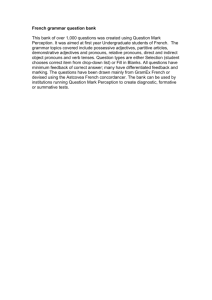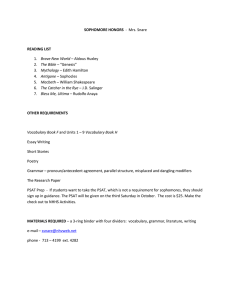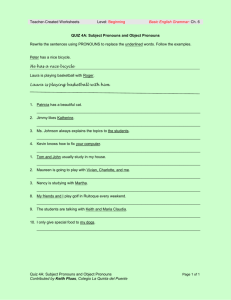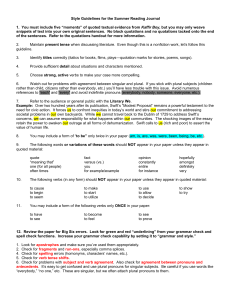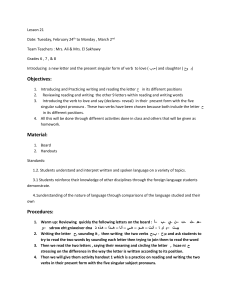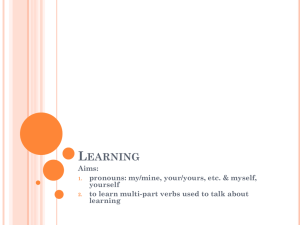Welcome to PSAT Prep!
advertisement
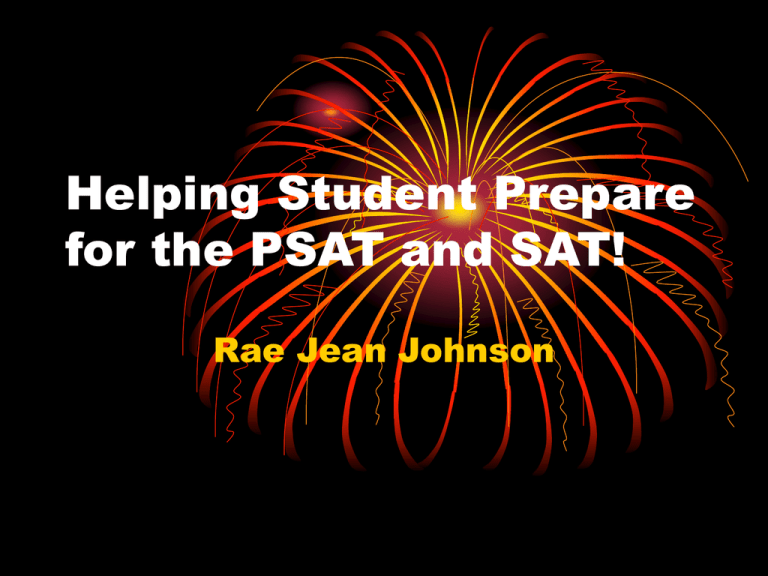
Helping Student Prepare for the PSAT and SAT! Rae Jean Johnson How important is the PSAT? It isn’t really as important as the mom above suggests, but the PSAT DOES a) indicate how well students might do on an SAT and b) determine if students are eligible for a National Merit Scholarship Award. Does the PSAT determine my future? Students are sometimes surprised to learn how important standardized tests can be. Scores may not determine whether students get into heaven, but they CAN determine if students get into the university they’d like or if they will get into the particular programs that interest them. What is a good PSAT score? • The answer to this depends on students’ goals…. • National Merit Scholars need a Selection Index (score) of +200. • Students need to look at that schools’ websites for their requirements for the SAT (they won’t list a PSAT score!). Just the facts… • The PSAT will be given Oct. 12 to all sophomores and juniors. • The PSAT is similar to the SAT except there is no essay and the test is a bit shorter What’s on the PSAT? • Math • basic math, Algebra I and II, geometry • Reading • Sentence completion questions, critical reading • Writing • Identifying sentence errors, improving sentences, improving paragraphs (No essay – this is on the SAT) To improve their scores, students should…. • • • • Understand test format Learn and practice strategies Read challenging texts Actively study SAT vocabulary words. • Practice, practice, practice! PSAT test format • Five sections • • • • • Critical reading (25 Min.) Mathematics (25 Min.) Critical reading (25 Min.) Mathematics (25 Min.) Writing Skills (30 Min.) • The SAT has TEN sections! PSAT (and SAT) Rules to know • Every section is timed, so pacing is important. • Scoring: right – (wrong x .25) • Students may omit questions • Pencils are required. • Calculators are allowed (please encourage the kids to bring one!) Critical reading • • • • Sentence Completion Short passages Long passages Dual (either long or short) passages Sentence Completion • Questions are arranged in increasing difficulty. • Effective strategies include: • • • • Step One: Cover the answers. Step Two: Speak for yourself. Step Three: Classify blanks +, -, or n. Step Four: Use context clues to eliminate answer choices. • Step Five: POE! Practice! 8. The very thought of her eating meat was -----to Lara, who had been a strict vegetarian and animal rights activist for many years. A. B. C. D. E. gratifying deleterious pedestrian anathema cathartic Two Blanks – Twice as Easy!! • 1. Cover the answers. • 2. Look at the second blank first. • 3. POE that blank. • 4. Then look at the other blank at ONLY the answers you have remaining. Example Frederick Douglass’ skills as ___________ were never more evident than when he spoke __________, delivering unrehearsed speeches of unsurpassed eloquence and clarity A. B. C. D. E. An explicator …. An orator … An obfuscator … A diplomat … A rhetorician … belligerently cryptically improvisationally censoriously extemporaneously Long passages • Read the blurb! • Speed read to get the general idea of the passage. • Answer “fetch” questions first (vocabulary in context, antecedents, details, etc.) • Then answer the “reasoning” questions. Dual passages • Skim the questions to see whether more can be answered by passage 1 or 2 then begin with that passage. • Read that passage and then answer the questions for that passage first. • POE the answers for the 1st passage. • Then read passage 2 and answer questions for that passage. Math Strategies • Format: • Every math section begins with reference information that includes things like area of a circle, volume of a rectangle, etc. • Questions are arranged in order of increasing difficulty. • One section will include grid-in problems. These are also arranged in increasing difficulty. Objectives • • • • • • Students should be able to….. Ballpark PITA POE POOD Pace yourself Special Topic: Grid-Ins • Start on the left of the grid. • DO NOT ROUND! • Bubble improper fractions instead of mixed numbers (3/2 would be correct. 1 ½ will look like 11/2 to the program!) Math • Expect to be rewarded for being wrong! ETS knows how students will work the problems and answer choices will include the wrong answers the kids will get. Math: PITA (plug in the answer) • The answer choices are arranged either from least to greatest or from greatest to least, so start with C when plugging in answers! Plugging in Tips • Try numbers that make the math easy (2, 5, 10 usually work well.) • Don’t worry about picking a bad number. You can always change the number and try again. • Make sure that your numbers satisfy any conditions in the problem. (If the question says to use an odd integer, use an odd integer!) Try plugging in your own answer here. 4. Which of the following expressions represents an odd integer if b is an odd integer? A. b-3 B. 2b-3 C. 2b-4 D. 3b-1 E. 3b+1 • Plug in 5 A. 5-3=2 B. 10-3=7 C. 10-4=6 D. 15-1=14 E. 15+1=16 Try ballparking this one! 12.After a sale at the local department store, the total number of television sets in private homes in Greene County rose from 17,800 to 24,000. By approximately what percent did the total number of television sets increase? A. 16% B. 35% C. 50% D. 65 % No calculators! • Use estimates: started about 18,000…ended at 24,000, a difference of about 6,000. Is 6,000 about 50% of 18,000? No way! So, that eliminates answers C, D, and E. • 6,000 is about 1/3 of 18,000 so B is best! Know your own POOD! • • • • Personal Order Of Difficulty POOD • Know your areas of strength and START there on the test. • No one knows where you bubble first or last! Writing: Multiple Choice • Error Identification • Improving Sentences • Improving Paragraphs Error Identification and Improving Sentences Understanding the Questions • Arranged in order of increasing difficulty • Expect 1/5 of the answers to be E – no error! • POE the answers EVERY TIME! Rules to know: Verbs • Subject – Verb Agreement • • • • 1+1=2 2+2=2 1+2=2 2+1=2 1 means singular 2 means plural Rules to know: Verbs • Subject-verb agreement • • • • 1 2 1 2 or or or or 1 2 2 1 = = = = 1 2 2 1 The conjunction can be either, neither, nor, or, not only, but also Rules to know: Verbs • Collective nouns – a singular noun that refers to a group of people and takes a singular verb. • The band (was/were) performing. • The class (is/are) behaving badly. Rules to know: Verbs • Indefinite pronouns as subjects • These are SINGULAR pronouns: • Each, everybody, neither, much, everyone, either, nothing, everything, everywhere, anyone, someone, no one, etc. • Each if the boys (is/are) doing (his/their) homework. • Someone forgot (his or her/their) notebook. • Either if the options (is/are) fine with Rules to know: Verbs • These pronouns can be either singular or plural depending on the noun the pronoun refers to • All, most, some, more, any, less, none • All of the pie (is/are) gone. • All of the students (is/are) asleep. Rules to know: Verbs • Parallelism • Similar grammatical structure • Keep lists in the same form throughout a sentence. • The Halloween part was a great success: the children enjoyed bobbing for apples, playing arty games, and to wear costumes. Rules to know: Verbs • Keep verbs in the same tense throughout the sentence! • Yesterday, much to the dismay of his wife, the new anchorperson has worn a red necktie that did not match his green suit. Rules to know: Pronouns • Know this chart: SUBJECT OBJECT POSSESSIVE PRONOUNS PRONOUNS PRONOUNS He We She You They Who It I Him us Her you Them whom It me His our/s Her/s your/s Their/s whose Its my/mine Rules to know: Pronouns • Use subject pronouns where subjects go in sentences • She is going to the store. • I am going to the store. • She and I are going to the store. • NOT…Me and her are going to the store! • Which one? This is she/her. Rules to know: Pronouns • Use object pronouns as direct objects, indirect objects, and objects of prepositions. • Sue gave him a rose. • Sue gave me a rose. • Sue gave him and me a rose. • Not: Sue gave him and I a rose. Rules to know: Pronouns • Use possessive pronouns in front of gerund (a verb + -ing that acts like a noun) • Her failing the class is a concern. • His sighing annoys me. Rules to know: Pronouns • Who and Whom refer to a person only • When is used only to refer to a time. • Where refers to only a place • A sentence can use one or you but only one per sentence Rules to know: Pronouns • A pronoun must clearly replace only one noun. • Billy saw Carol and Jane near the pool and flirted with her shamelessly. Who??? • They saw their parents at the school and talked to them until they got there from the trip. Huh??? Rules to Know: Parallel structure • Keep parts of the sentence in the same form • I like to walk, to run, and swimming. Improving Paragraphs • There are three kinds of questions here • Revision questions • How can the paragraph be improved – organization, adding a topic sentence, eliminating an extraneous sentence, etc. • Combination questions • Best way to combine sentences • Weird questions • Split paragraphs • Join paragraphs • Adding topics What’s Next? • Practice! • Use resources like 11 Real SATs, Rock the SAT, etc!
